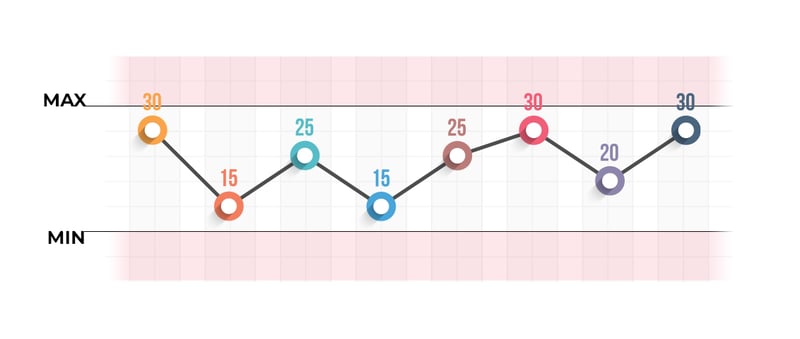Recap: the concept repricing
First, just the basic concept of repricing; adjusting the price of your product on the marketplace, based on your terms and the competition on the platform, within the minimum and maximum price limits you set. Important in this are those price limits. The minimum price ensures that you never sell below your absolute minimum, while the maximum price ensures that you are not overpriced.

The sum of price components
You determine the minimum price by adding up all the price components that play a role. There are some fairly simple price components, such as your purchase price and the VAT rate. But, there are also price components that are quite dependent, such as your shipping costs and the marketplace commission. It is precisely by dealing cleverly with these conditional price components that you can make the difference when it comes to getting results from marketp
Changing data leads to conditional price components
Data Driven Repricing is, as the name implies, repricing that is driven by data. So then also adjusted repricing when that data changes because of a different competitive situation, or changes because another piece of data changes (e.g. your shipping costs, because you now sell the product on bol.com through LVB). So your data, the price components in your formulas for your prices, are then conditional. The advantage of conditional data, is that the data applies per specific product, and is not an average for all products.
From average costs to accurately specified values
Most marketplace sellers work with average costs when it comes to price components. This has come about because they often do not have the possibility to include those price components (e.g. shipping costs) per product for the entire assortment, which often consists of thousands of products. Since these averages are then not specific enough for each product, multiple pricing rules are created, eventually creating a plethora of rules and losing the overview of which rule is applied for pricing the products.
With conditional pricing components that can be used as variables in pricing formulas, pricing components such as shipping costs in the example above can be determined for any specific product, no matter how large the catalog. And, less contamination is created by a large set of pricing rules. Win-win!
Shipping costs based on stock location
Let's take shipping costs as an example. The shipping costs for a product often depend on the product itself (e.g. its weight), but also on the location where the product is stored. That could be your own warehouse, an external warehouse at a fulfillment company, or, e.g., a marketplace's warehouse (like, e.g., bol.com's LVB). The costs you incur in shipping a product are therefore often different. LVB involves different costs than shipping from your own warehouse, or shipping through a fulfillment company. So the price component "shipping costs" that you use in your pricing formulas must take this into account. Within the marketplace integration platform of EffectConnect you can use a conditional custom attribute to determine these shipping costs and at the same time take into account where the stock is located. This way you never under count shipping costs for your products.
Include conditional pricing components in your pricing formulas
Now that we have determined product-specific shipping costs based on logic that looks at the properties of the product (size/weight) and the location where the product is stored (one of the warehouses from the example above), we can start using these "shipping costs" as a variable in the pricing rules.
In the image above you can see an abstract representation of a pricing formula, in which we have included shipping costs as a variable component (we call this within the EffectConnect platform a "placeholder") in the formula. If you would also do this for the margin, VAT rate and commission, you can reduce the number of price lines to a single price line. That way you will have the overview much faster and an optimization in your formulas will be directly applicable to your entire assortment!
Bonus: Set delivery time based on stock location
Okay. this one doesn't have as much to do with pricing. But, I do want to take a moment to show you that data and logic have much broader applications at marketplaces than just to help determine the right price. The beauty of data-driven work within EffectConnect is that you can use that data in different places in the platform, not just in pricing rules. So, based on the logic shown earlier, you could also determine the delivery time for your products, after all, the cut-off time of your external warehouse can be quite different from that of your own warehouse. That way, your delivery promise always matches reality. Knowing that this is one of the most important KPIs of the marketplace is definitely worth your attention!
Once you have determined the cut-off time based on your inventory location, you can easily set those cut-off times within the EffectConnect platform for the marketplace you sell on. Below is an example of what such a "delivery time mapping" looks like for bol.com.